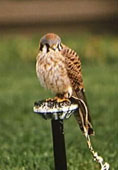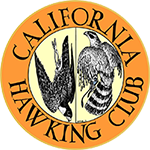CHC Apprentice Chairs
Northern (Fresno north)
Southern (South of Fresno)
 |
 |
SO, YOU WANT TO BE A FALCONER! Congratulations! You've done the hard part. You found us. We weren't hiding, but there are so few of us that we're just not easy to locate. You've started a process that can be tedious and time consuming, but will never be very difficult, and far more rewarding and satisfying than any non-falconer will ever believe. Of the over 300 people that started in a typical year, less than 40 stayed the course. Are you the one in eight who will go all the way?
Up-front questions you need to be able to answer to yourself:
1. Will you, can you, commit part of your waking hours to a creature who at the very best of times will merely tolerate your presence, is as affectionate as a stone, and at the worst of times will cause you heartache and puncture wounds? Can you commit to an average of a half-hour a day, every day, and two to four hours on a hunting day, regardless of school, family, or job - forever?
2. Are you 12 or older?
3. Are you an outdoors person? Do you like animals? Are you a hunter? Will you be able to hunt three to six times a week during the hunting season on the hawk's schedule - not yours? If you've never hunted, can you learn?
4. Will you be able to convince the California Department of Fish and Wildlife, and at least one general or master level falconer that you have the drive, the dedication, the motivation, the book knowledge, the facilities and equipment to properly house and care for a Redtailed hawk or an American kestrel?
5. Are you ready to be one of that elite band of hunters in the most awesome sport on the face of the earth? Are you ready to have people see you with awe, amazement and sometimes anger? Are you ready to be the absolute center of attention whenever you carry your hawk on your fist? Are you ready for that incredible rush when that wild creature first returns to you, on its own and able to fly free but decides to come to you instead?
Answers: Only the first two really count. The third one can be learned. The fourth is a lot easier than it reads. And the last is reason enough.
Other questions you must start thinking about are:
1. Which hawk do you want to begin with? You get to choose between the American kestrel, America's smallest falcon, and the redtailed hawk, one of America's largest hawks.
2. What are you going to hunt for, and where are you going to hunt? Falconry kestrels hunt small birds, while the Redtailed hunts ground quarry.
3. Where are you going to house the hawk?
4. How are you going to transport the hawk between house and the hunt?
Through links on this page, you'll find:
1. The Eight Steps. A listing of the chronological steps you need to follow to become an apprentice falconer with a hawk. Follow these steps, in this order, and you will become a falconer.
2. The Apprentice's Bookshelf. A listing, with sources, of the books that will help you through the various steps from taking the test to getting that hawk. While there are many interesting books on falconry, I recommend only those that proved useful to me becoming a falconer and that are available in print.
3. The Apprentice's Checklist. After you have passed the state's falconry exam you will have to have your facilities and equipment inspected and approved by a game warden. If you can answer "yes" to the items on this checklist, you will pass that inspection.
4. A membership application to the California Hawking Club. There are about 700 falconers in California (of 4,000 nationwide) and we are the only falconry support group that exists for California (you are getting this free from the club on our web page). After you pass the state exam and before you can get your facility inspection, you will need a sponsor. The sponsor guides you in creating your hawk house, getting your hawk, manning and feeding it, hunting with it, and so on. Unless you are fortunate enough to know a master or general falconer willing to sponsor you, you will end up talking to one of the California Hawking Club's Apprentice Chairs for the names of candidate sponsors. These sponsors come from the ranks of the California Hawking Club. Other benefits include the club's Newsletters and Journals, plus the fellowship of people who can and will share the experiences that you are going to be going through. We expect you to join the club. If you can afford a Jack-in-the-Box® meal once a month, you can afford to join the club. You can join before you have a hawk, take the test, or finish reading this.
5. We're often asked for sources of equipment. Please check our sponsor page for contact information about vendors.
6. We're often asked, "how much it costs." As I said above, this information comes free from the club. It's just about the last thing in falconry that's free. Keep your checkbook handy. Falconry is not a sport you can do on a shoestring, but you don't have to be independently wealthy either. The good news is that wild-caught hawks cannot be bought or sold (state and federal law). They may be trapped or transferred to you at anytime of the year, consequently your first hawk costs nothing - directly. However, building the hawk house, getting a proper perch, swivel, glove and so on (see The Apprentice's Checklist for the mandatory requirements) cost me about $1000. Compared to skiing, mountain climbing, or deer hunting, it's a lot less. Annual licensing fees (state is $94 - 2013), hunting license ($46 - 2013), and CHC membership ($40). That sounds like a lot at one gulp for the first year. Many people build (and enjoy building) their own hawk house, perch, and so on, cutting that down considerably. The mews inspection by a game warden will be $259.
7. Schools. Currently, two schools exist in Northern California and one in Southern California. Be aware that current law does not accept any form of schooling as a reduction in a two-year apprenticeship.
The first is The West Coast Falconry Center in Browns Valley, near Marysville, Yuba County www.westcoast-falconry.com
The second is The Center for Reconnecting with Nature in Browns Valley, near Marysville, Yuba County www.thecrwn.org
The third is West Coast Sky Falconry in Alpine, east of San Diego www.skyfalconry.com
While attendance at these schools will not reduce your apprentice term, you will acquire a much better understanding of the reality of what you think you want to get into. Students typically leave with one of two attitudes: "Yes! This is exactly what I want to do!" or "Hmmm. Maybe later." Contact them for current offerings and schedule.
8. What do we expect from you? In your first year, we expect you to trap, man, train, and hunt with a passage redtail or kestrel. Ninety-nine percent of apprentices begin with the redtail. Many beginners get the impression that because redtails and kestrels are used by apprentices they are easy birds to work with. That is not the case. The only reason those hawks are allowed you is because they are successful as a species and are fairly plentiful. While they are not the easiest birds to work with, they are not difficult to work with. Once you successfully hunt with a redtail, the other ground-oriented species are easy. Once you hunt successfully with a kestrel, you will find the larger falcons to be just that - larger, more impressive, certainly, but not harder to work with. If the magic doesn't work and it becomes obvious to you and/or your sponsor that falconry just isn't for you, we expect you to release your hawk. Falconry isn't everybody's cup of tea. Having to release your bird because you aren't cut out to be a falconer is extremely rare, on the order of less than one a year, but it's better than causing irreparable damage to you or one of our treasured hunting partners.
What you need to do next:
1. If you have not already done so, email, call or write: Note: It is quicker to email Melanie Huetter directly
This email address is being protected from spambots. You need JavaScript enabled to view it.
Department of Fish and Game
1740 North Market Boulevard
Sacramento, CA 95834
(916) 902-9106
and ask for "the package for getting into falconry." It contains the state regulations, forms and procedures, and the federal regulations.
2. Get your books [see The Apprentice's Bookshelf] and start studying.
3. When you feel that you're ready, schedule an appointment with your Fish and Game regional office to take the falconry exam. Please be aware that some regional offices have insisted that prospective falconers acquire a sponsor before the falconry exam can be scheduled. The DFW headquarters office in Sacramento assured us that this is not required.
4. After you've passed the falconry exam and joined the CHC, contact the CHC apprentice contacts and, after determining your dedication and motivation, you'll be given some potential sponsor contacts. Caution: This is after you've proven you're really serious about this, in other words, after you've passed the falconry exam and joined the club. It seems like a lot of work. Heck, it is a lot of work! But the first time that wild creature freely comes to you and lands on your fist, the tediousness of training, seemingly endless bothers with the hawk, spouse, friends, neighbours, the bureaucracy, and animal rights people, will be forgotten like they never existed or ever mattered.
